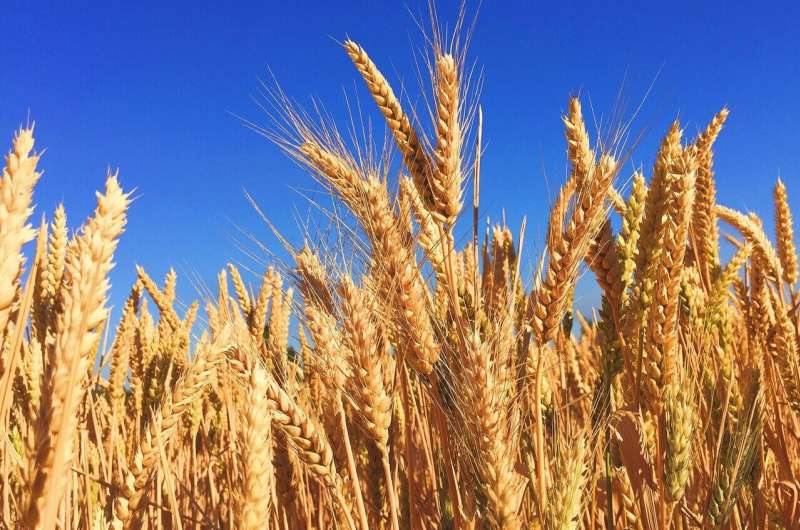Simulations show using novel wheat genotypes coupled with deep sowing can increase yields

A quartet of researchers with CSIRO Agriculture & Food in Australia has found via simulations that planting novel wheat genotypes using deep sowing could increase yields. In their paper published in the journal Nature Climate Change, Zhigan Zhao, Enli Wang, John Kirkegaard and Greg Rebetzke, describe how they used data from a variety of sources to create a simulation to show how wheat yields in Australia might be increased as conditions grow warmer and drier.
Most large-scale wheat farming operations, including those in Australia, are based on semi-dwarf varietals that were developed decades ago to increase yields. Such varieties increased yields because they were less prone to damage from wind and because they took less time to mature and were more responsive to fertilizer. But they have an Achilles heel—short coleoptiles.
Coleoptiles are sheathings that protect young shoots. The shortness means they need moist soil near the surface to survive. But as global warming progresses, soil near the surface grows warmer and drier. And because of that, scientists in Australia are worried that the semi-dwarf varieties will not grow under the increasingly hot sun found in Australia’s wheat fields. The researchers with this new effort suggest the solution is clear—Australian wheat farmers need to switch to newer varieties of wheat—ones that have longer coleoptiles allowing them to reach down deeper into the soil where it is wetter. They also need to plant their crops earlier to allow them to mature before the hottest summer weather arrives.
To come to these conclusions, the researchers developed a framework that allowed for integrating the physiological effects of gibberellic-acid-sensitive dwarfing genes on coleoptile growth and the vigor they might show in the real world. They then added data from both the real world and the framework into an agricultural production system simulator that took into account the conditions that are likely to exist in the parts of Australia used for growing wheat as the planet warms.
The simulations showed that switching to such novel wheat genotypes and also using deeper and earlier sowing could increase yields by 18 to 20%, under current conditions. They claim their simulations suggest that such changes could also help to prevent crop loss due to warming temperatures. And they further suggest that the same approach could also be used to prevent wheat yield decreases in other parts of the world in the coming years.
More resilient Aussie wheat needed as climate change heats up
Zhigan Zhao et al, Novel wheat varieties facilitate deep sowing to beat the heat of changing climates, Nature Climate Change (2022). DOI: 10.1038/s41558-022-01305-9
© 2022 Science X Network
Citation:
Simulations show using novel wheat genotypes coupled with deep sowing can increase yields (2022, March 9)
retrieved 9 March 2022
from https://phys.org/news/2022-03-simulations-wheat-genotypes-coupled-deep.html
This document is subject to copyright. Apart from any fair dealing for the purpose of private study or research, no
part may be reproduced without the written permission. The content is provided for information purposes only.
For all the latest Science News Click Here
For the latest news and updates, follow us on Google News.

